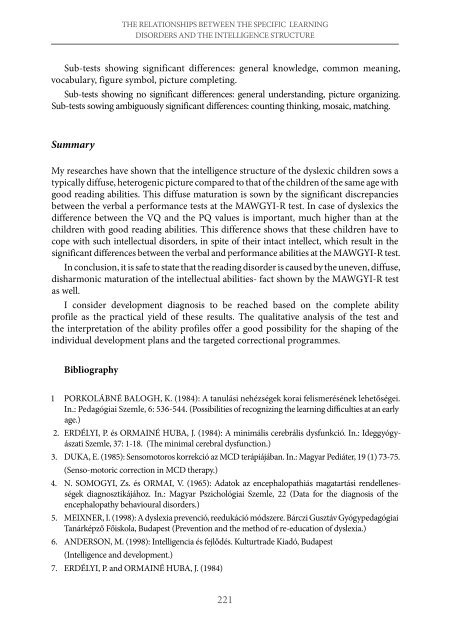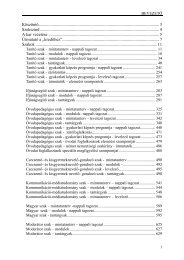ACTA SZEKSZARDIENSIUM - Pécsi Tudományegyetem Illyés Gyula ...
ACTA SZEKSZARDIENSIUM - Pécsi Tudományegyetem Illyés Gyula ...
ACTA SZEKSZARDIENSIUM - Pécsi Tudományegyetem Illyés Gyula ...
You also want an ePaper? Increase the reach of your titles
YUMPU automatically turns print PDFs into web optimized ePapers that Google loves.
THE RELATIONSHIPS BETWEEN THE SPECIFIC LEARNING<br />
DISORDERS AND THE INTELLIGENCE STRUCTURE<br />
Sub-tests showing significant differences: general knowledge, common meaning,<br />
vocabulary, figure symbol, picture completing.<br />
Sub-tests showing no significant differences: general understanding, picture organizing.<br />
Sub-tests sowing ambiguously significant differences: counting thinking, mosaic, matching.<br />
Summary<br />
My researches have shown that the intelligence structure of the dyslexic children sows a<br />
typically diffuse, heterogenic picture compared to that of the children of the same age with<br />
good reading abilities. This diffuse maturation is sown by the significant discrepancies<br />
between the verbal a performance tests at the MAWGYI-R test. In case of dyslexics the<br />
difference between the VQ and the PQ values is important, much higher than at the<br />
children with good reading abilities. This difference shows that these children have to<br />
cope with such intellectual disorders, in spite of their intact intellect, which result in the<br />
significant differences between the verbal and performance abilities at the MAWGYI-R test.<br />
In conclusion, it is safe to state that the reading disorder is caused by the uneven, diffuse,<br />
disharmonic maturation of the intellectual abilities- fact shown by the MAWGYI-R test<br />
as well.<br />
I consider development diagnosis to be reached based on the complete ability<br />
profile as the practical yield of these results. The qualitative analysis of the test and<br />
the interpretation of the ability profiles offer a good possibility for the shaping of the<br />
individual development plans and the targeted correctional programmes.<br />
Bibliography<br />
1 PORKOLÁBNÉ BALOGH, K. (1984): A tanulási nehézségek korai felismerésének lehetőségei.<br />
In.: Pedagógiai Szemle, 6: 536-544. (Possibilities of recognizing the learning difficulties at an early<br />
age.)<br />
2. ERDÉLYI, P. és ORMAINÉ HUBA, J. (1984): A minimális cerebrális dysfunkció. In.: Ideggyógyászati<br />
Szemle, 37: 1-18. (The minimal cerebral dysfunction.)<br />
3. DUKA, E. (1985): Sensomotoros korrekció az MCD terápiájában. In.: Magyar Pediáter, 19 (1) 73-75.<br />
(Senso-motoric correction in MCD therapy.)<br />
4. N. SOMOGYI, Zs. és ORMAI, V. (1965): Adatok az encephalopathiás magatartási rendellenességek<br />
diagnosztikájához. In.: Magyar Pszichológiai Szemle, 22 (Data for the diagnosis of the<br />
encephalopathy behavioural disorders.)<br />
5. MEIXNER, I. (1998): A dyslexia prevenció, reedukáció módszere. Bárczi Gusztáv Gyógypedagógiai<br />
Tanárképző Főiskola, Budapest (Prevention and the method of re-education of dyslexia.)<br />
6. ANDERSON, M. (1998): Intelligencia és fejlődés. Kulturtrade Kiadó, Budapest<br />
(Intelligence and development.)<br />
7. ERDÉLYI, P. and ORMAINÉ HUBA, J. (1984)<br />
221




